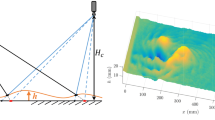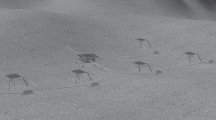Abstract
In this article we present a video-based method for river flow monitoring. The proposed method aims at deriving efficient approximations of the river velocity using natural formations on the river surface. In order to overcome peculiarities of the flow, we propose to uniformly exploit all such structures that appear locally with short temporal duration. Towards this direction we explore the expanded capabilities of a stereoscopic camera layout with the dual observation fields and the potential of reverting projective deformations. By mapping to world coordinates, all spatial locations in the video reflect velocity as a uniform field, except for local flow variations. The velocity estimation is performed by computing the optical flow using a series of video frames, combining the information of the views of both cameras. The novelty of the proposed river flow estimation scheme lies on the fact that the accuracy of motion estimation is increased due to the use of the complementary views, which also enables the transition from a 2-Dimensional image-based velocity estimate to 3-Dimensional estimates. The estimated optical velocity is back-projected to the real world coordinates using the parameters extracted using the stereoscopic layout. The results on simulated and real conditions demonstrate that the proposed method is efficient in the estimation of the surface velocity and robust against locally disappearing formations, since it can compensate for a loss with other formations active in the field of view.













Similar content being viewed by others
References
Bacharidis K, Moirogiorgou K, Sibetheros I, Savakis A, Zervakis M, River Flow Estimation Using Video Data (2014) IEEE International Conference on Imaging Systems and Techniques (IST2014). Santorini Island, Greece, pp 173–178
Bay H, Ess A, Tuytelaars T, Van Gool L (2008) SURF: Speeded Up Robust Features. Comput Vis Image Underst 110(3):346–359
Bradley A, Kruger A, Meselhe EA, Muste M (2002) Flow measurement in streams using video imagery. Water Resour Res 38(12):1315
Chang J, Edwards D, Yizhou Y (2002) Statistical Estimation of Fluid Flow Fields. ECCV workshop on Statistical Methods in Video Processing, Copenhagen, pp 91–96
Chen X, Zillé P, Shao L, Corpetti T (2015) Optical flow for incompressible turbulence motion estimation. Exp Fluids 56:8. https://doi.org/10.1007/s00348-014-1874-6
Chorin AJ, Marsden JE (1990) A mathematical introduction to fluid mechanics. Springer-Verlag, New York Texts in Applied Mathematics 4
Creutin JD, Muste M, Bradley AA, Kim SC, Kruger A (2003) River gauging using PIV techniques: a proof of concept experiment on the Iowa river. J Hydrol 277:182–194
Fritz HM, Phillips DA, Okayasu A, Shimozono T, Liu H, Mohammed F, Skanavis V, Synolakis CE, Takahashi TT (2011) Japan tsunami current velocity measurements from survivor videos at Kesennuma Bay using Lidar. Geophys Res Lett 2012:39
Fujita I, Tsubaki R (2004) Measurements of vorticity field from river flow images, vol V0032. Int. Conf. on Advanced Optical Diagnostics in Fluids Solids and Combustion, Tokyo
Fujita I, Muste M, Kruger A (1998) Large-scale particle image velocimetry for flow analysis in hydraulic applications, J. Hydraul Res 36(3):397–414
Fujita I, Watanabe H, Tsubaki R (2007) Development of a non- intrusive and efficient flow monitoring technique: the space-time image velocimetry (STIV). Int J River Basin Manag 5(2):105–114
Gui L, Wereley ST (2002) A correlation-based continuous window- shift technique to reduce the peak-locking effect in digital PIV image evaluation. Exp Fluids 32:50617
Hartley R, Zisserman A (2003) Multiple view geometry in computer vision. Cambridge University Press, New York
Has P, Herzet C, Mmin E, Heitz D, Mininni PD (2013) Bayesian estimation of turbulent motion. IEEE Trans Pattern Anal Mach Intell 35(6):1343–1356
Hauet A, Kruger A, Krajewski W, Bradley A, Muste M, Creutin J, Wilson M (2008) Experimental system for real-time discharge estimation using an image-based method. J Hydrol Eng 13(2):105–110
Heikkilä J, Silvén O (1997) A four-step camera calibration procedure with implicit image correction. In: Proceedings of the 1997 I.E. Computer Society Conference on Computer Vision and Pattern Recognition, 1997. IEEE, pp 1106–1112. https://doi.org/10.1109/CVPR.1997.609468.
Hoyt WG, Langbein WB (1939) Some general observations of physiographic and climatic influences on floods. EOS Trans Am Geophys Union 20:166–174
Huang HT, Fiedler HE, Wang JJ (1993) Limitation and improvement of PIV: part I. Limitation of conventional techniques due to deformation of particle image patterns. Exp Fluids
Jonkman SN (2005) Global perspectives on loss of human life caused by floods. Nat Hazards 34:151–175
Kääb A, Leprince S (2014) Motion detection using near-simultaneous satellite acquisitions. Remote Sens Environ 154:164–179
Kim Y (2006) Uncertainty analysis for non-intrusive measurement of river discharge using image velocimetry. Ph.D. dissertation, Univ. of Iowa, Iowa City
Le Boursicaud R, Pénard L, Hauet A, Thollet F, Le Coz J (2016) Gauging extreme floods on YouTube: application of LSPIV to home movies for the post-event determination of stream discharges. Hydrol Process 30:90–105
Lecordier B, Demare D, Vervisch LM, Riveillon J, Triniti M (2001) Estimation of the accuracy of PIV treatments for turbulent flow studies by direct numerical simulation of multi-phase flow. Meas Sci Technol 12:1382–1391
Nakajima Y, Inomata H, Nogawa H, Sato Y, Tamura S, Okazaki K, Torii S (2003) Physics-based flow estimation of fluids. Pattern Recogn 36:1203–1212
Ralli J (2011) PhD thesis, Fusion and regularisation of image information in variational correspondence methods, Universidad de Granada. Departamento de Arquitectura y Tecnologa de Computadores. http://hera.ugr.es/tesisugr/20702371.pdf
Saikano H (2008) Fluid motion estimation method based on physical properties of waves. Comp. Vision and Pat. Recognition (CVPR)
Saikano H (2015) Motion estimation for dynamic texture videos based on locally and globally varying models. IEEE Trans Image Process 24(11):3609–3623. https://doi.org/10.1109/TIP.2015.2447738
Baker Simon, Scharstein Daniel, J. P. Lewis, Stefan Roth, Michael J. Black, Richard Szeliski (2007) A database and evaluation methodology for optical flow. Int Conf Comput Vis 1–8. https://doi.org/10.1109/ICCV.2007.4408903
Trucco E, Verri A (1998) Introductory techniques for 3-D computer vision. Prentice Hall, Upper Saddle River. http://cseweb.ucsd.edu/classes/fa12/cse252A-a/hw4/trucco_verri_pp178-194.pdf
Tsubaki R (2011) I Fujita, S Tsutsumi, Measurement of the flood discharge of a small-sized river using an existing digital video recording system. J Hydro Environ Res 5:313–321
Vescoukis V, Doulamis N, Karagiorgou S (2012) A service oriented architecture for decision support systems in environmental crisis management. Futur Gener Comput Syst 28(3):593–604
Westerweel J, Dabiri D, Gharib M (1997) The effect of a discrete window offset on the accuracy of cross-correlation analysis of digital PIV recordings. Exp Fluids 23:20–28 Springer-Verlag
Wildes RP, Amabile MJ, Lanzillotto A, Leu TS (2000) Recovering estimates of fluid flow from image sequence data. Comput Vis Image Underst 80:246–266
Zhang Z (1999) Flexible camera calibration by viewing a plane from unknown orientations. In: The Proceedings of the Seventh IEEE International Conference on Computer Vision, 1999 ((Vol. 1, pp 666–673). IEEE. https://doi.org/10.1109/ICCV.1999.791289
Acknowledgements
This work is elaborated through an on-going THALES project (CYBERSENSORS – High Frequency Monitoring System for Integrated Water Resources Management of Rivers). The project has been co-financed by the European Union (European Social Fund - ESF) and Greek national funds through the Operational Program “Education and Lifelong Learning” of the National Strategic Reference Framework (NSRF) – Research Funding Program: Thales. Investing in knowledge society through the European Social fund.
Author information
Authors and Affiliations
Corresponding author
Rights and permissions
About this article
Cite this article
Bacharidis, K., Moirogiorgou, K., Koukiou, G. et al. Stereo System for Remote Monitoring of River Flows. Multimed Tools Appl 77, 9535–9566 (2018). https://doi.org/10.1007/s11042-017-5148-1
Received:
Revised:
Accepted:
Published:
Issue Date:
DOI: https://doi.org/10.1007/s11042-017-5148-1




